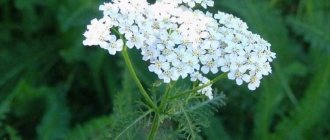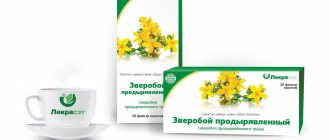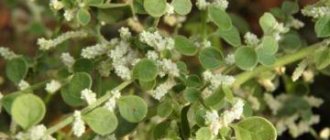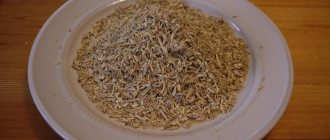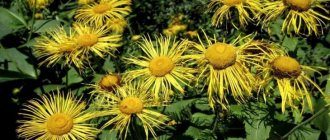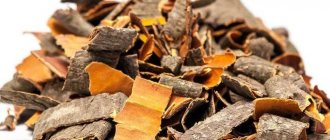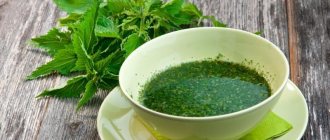The swamp is fraught with many natural resources, one of which is unique medicinal plants. Their most valuable representative is marsh cinquefoil, popularly referred to as “the grass of a thousand ailments.” Medicinal teas, all kinds of tinctures and decoctions are prepared from it, and are also actively used in the pharmacological industry. Today we will look at the beneficial properties and contraindications of marsh cinquefoil, how and when the plant is collected for treatment, what drugs are made from it, and how it is used in folk medicine.
Where does cinquefoil grow and how to distinguish it
If you don’t know what cinquefoil is, then perhaps you are familiar with decopa grass, marsh cinquefoil, cinquefoil, fieldfare, and nutasai. This is only a part of the many popular names for the same plant. To make sure you don’t confuse it with anything else, carefully study the photo of cinquefoil.
during flowering
Its main distinguishing feature is the unusual bright burgundy flowers in the shape of a five-pointed star.
The leaves, like the petals, are oblong with pointed ends. As you can see in the photo, the plant is quite large. This is a subshrub from 50 to 100 cm in height. The roots of cinquefoil, which are comparable in healing power to ginseng, deserve special attention. It is not easy to obtain them, since the creeping rhizome grows up to 3 m in length and is strongly intertwined, forming a strong root cushion.
The cinquefoil grows throughout Russia - from the European part to the regions of the Far North. It loves areas with high humidity, so you need to look for it in river valleys, swamps and damp meadows.
Collection and preparation of plants
To truly benefit from the plant, it is important to know how to prepare it correctly. The time for collecting the aerial parts and rhizomes varies .
Stems and leaves are harvested during the flowering period, from early June to late July. The collected herbs should be dried in the shade, in a well-ventilated place, stirring occasionally. Then it is packaged in paper or fabric bags and stored in a dark, dry place. Under such conditions, the raw materials will retain their beneficial properties for 2 years.
The root is collected in late autumn or early spring, when its healing power is not wasted on feeding the aerial parts.
Only the top young roots are cut off, without touching the blackened old ones, which no longer have medicinal properties. This method allows you to harvest without destroying the plant. The washed roots are dried in the sun so that excess moisture is removed faster and they do not rot. They are stored in the same conditions as grass.
Not everyone has the opportunity to go to the swamp, so cinquefoil can also be purchased at the pharmacy. There are presented both dried parts of the plant and all kinds of preparations based on it, which we will talk about later.
Medications
Herbal preparations can also be found in pharmacies. The root of cinquefoil in various forms is used in complex treatment, does not cause side effects and is in demand. You can purchase the product without a doctor's prescription. Pharmacies offer drugs in the form of tablets, tinctures, creams, balms and teas. The price range ranges from 30 to 300 rubles, depending on the shape and quantity.
What does marsh cinquefoil help with?
Let's move on to the main thing - how cinquefoil is useful. Its widespread use is due to the following medicinal properties:
- anti-inflammatory;
- antipyretics;
- immunostimulating;
- painkillers;
- antitumor;
- diuretics;
- astringents;
- chondroprotective (joint restoration).
Many questions arise about whether cinquefoil thickens or thins the blood. The plant is multifaceted and can give both of these effects at once, depending on the dosage. It contains quercetin and kaempferol, which strengthen the walls of blood vessels and help stop bleeding. But with high dosages of cinquefoil-based drugs, salicylates come into effect, which, on the contrary, thin the blood.
Now directly about what marsh cinquefoil helps with. Its leaves and stems are used mainly for preparing tonic drinks that cleanse the body of toxins and improve immunity, as well as for external use on wounds and burns.
What diseases does marsh cinquefoil herb
- gastritis;
- dysbacteriosis;
- diarrhea;
- boils, acne and other skin problems.
However, for the most part, it is the rhizomes of the plant that are used in the treatment of diseases.
What does root :
- arthrosis, arthritis, osteochondrosis, radiculitis and other problems with the spine and joints;
- respiratory diseases;
- endometriosis, polycystic ovary syndrome and many other gynecological problems;
- mastopathy;
- oncological diseases;
- heart and vascular diseases;
- cholecystitis;
- jaundice.
Sabelnik or larkspur: which is better?
Regarding the treatment of the musculoskeletal system, cinquefoil is often compared with larkspur (comfrey), since the properties of the plants are largely similar. However, the first has more pronounced anti-inflammatory properties, and the second heals microtraumas of the joints faster and increases the production of synovial fluid. Therefore, it is impossible to say which is better, cinquefoil or comfrey; to obtain the maximum effect in the treatment of joints, they should be used in combination.
Story
A description of a tonic drink made from cinquefoil root is found in written sources of the 17th century. The authors claim that it restores spirits and gives strength. The records of healers in eastern Siberia mention tea made from dekola, which saves from diseases and prolongs youth. This drink helped the inhabitants of Lapland survive the harsh polar nights; the roots of this plant drove away evil spirits, and the leaves of the plant were added to food for deer.
Residents of Chukotka and the Far East also knew about the healing power of “sick grass,” and recipes came to them from Mongolian and Japanese doctors. In Japan, cinquefoil is used in official medicine, and in recent years, studies have been conducted on the antitumor activity of the plant. In Chinese medicine, cinquefoil root is also popular. Based on it, drugs have been created for pain in muscles, joints and bones, including the famous pain relief patches.
Sabelnik is also used in cooking. Nutritionists recommend drinking cinquefoil during a therapeutic diet to enhance the effect and increase tone. Cooks add it as a seasoning to fish and meat dishes, to baked goods and vegetable dishes, to marinades and compotes to add flavor.
Medicinal properties and contraindications of cinquefoil for women
For the fair sex, first of all, the use of cinquefoil in gynecology is of interest. Its anti-inflammatory and antitumor properties have a beneficial effect on mastopathy, mastitis, vaginitis, and polycystic ovary syndrome. And thanks to its hemostatic properties, the plant is used for uterine bleeding and menstrual disorders.
Sabelnik in gynecology
- For mastopathy, a decoction of cinquefoil has proven itself well. 20 g of dry herb are brewed with a quarter liter of boiling water and simmered in a steam bath for 15 minutes, then filtered. Drink 20 ml 4 times a day. It is effective to combine the use of the decoction with external rubbing of the chest with cinquefoil ointment, the recipe for which has already been described earlier.
- Treatment of endometriosis is carried out by parallel intake of decoctions of cinquefoil and boron uterus. Both remedies are prepared according to the above recipe and drunk three times a day - a decoction of boron uterus half an hour before meals, and a decoction of cinquefoil 30 minutes after meals.
- For uterine bleeding, a collection is made from the roots of cinquefoil and burnet in a ratio of 2:3. 2 tbsp. collection, pour 0.5 liters of boiling water and leave in a thermos for at least 2 hours. Drink 100 ml 3 times a day on an empty stomach.
- The herb is also useful for women trying to lose extra pounds. To lose weight , drink cinquefoil tea, which normalizes lipid metabolism. In addition, such a drink cleanses the body of toxins, which has a positive effect on the condition of the skin and hair.
More interesting things
You are a sorceress, nettle! Saved me from goiter and radiation!
Contraindications for women
Despite the large number of medicinal properties for women, cinquefoil also has contraindications for them.
Their role is pregnancy and the period of breastfeeding. In such cases, treatment can only be carried out with the permission of a doctor and only under his supervision.
General strengthening effect
The roots of cinquefoil increase immunity and improve metabolism. They also restore damaged cells, remove waste and toxins. The medicinal properties of cinquefoil roots make this plant an indispensable component for herbal preparations for preventive purposes. Tea with cinquefoil gives strength, creates conditions for an active life and resists aging.
For cosmetic purposes, it is used as creams and face masks, which effectively smooth out wrinkles, help get rid of cellulite and give elasticity to the skin.
General contraindications to the use of cinquefoil
Despite the presence of a lot of useful properties, marsh cinquefoil has a minimum of contraindications and side effects. This plant is not poisonous, but some people may experience individual intolerance to it. If, in response to the first dose of cinquefoil-based medication, you experience indigestion or an allergic reaction to the skin, treatment should be stopped.
A child under 12 years of age is also a contraindication. It can be taken at an earlier age only as prescribed by a doctor.
Often the cause of side effects is not the plant itself, but the alcohol on the basis of which tinctures are made from cinquefoil. Patients are prohibited from taking such drugs:
- with liver and kidney diseases;
- epilepsy;
- bradycardia;
- alcohol addiction.
Sabelnik also affects blood pressure. It is not recommended for use for hypotension, as the pressure may drop even more.
We have figured out what cinquefoil root treats and for what diseases its herb is taken, so it’s time to move on to practical recommendations for using the plant.
What cures
Since ancient times, cinquefoil has been used to relieve toothache and joint pain, for tumors, bruises, and hemorrhoids. It helps reduce salt deposits in joints and regulate metabolism. After treatment with cinquefoil, joint mobility increases and the normal structure of cartilage is restored. All this makes it an indispensable plant for the treatment of osteochondrosis, vertebral hernia, and sciatica. Sabelnik strengthens the immune system, treats colds, stomach diseases, and ulcers. Crushed fresh leaves will help with wounds, trophic ulcers, boils or inflammation, mastitis, and bruises. Decoctions and tinctures are used for hepatitis, diarrhea, gastric bleeding, tuberculosis, tumors of the mammary gland and stomach. Sabelnik is also taken to prevent cancer. It helps cleanse blood and lymph.
Cinquefoil tincture: indications for use, recipes, reviews
The most popular and universal remedy is cinquefoil tincture with vodka or alcohol. Its effectiveness is explained by the ability of alcohol to dissolve any, even water-insoluble, components of the plant, and also very quickly deliver them to the source of the disease.
What does the tincture help with:
- joint problems;
- spinal hernia;
- diseases of the reproductive organs;
- gastrointestinal disorders.
In addition, taking the tincture has a positive effect on the body’s condition in case of hypertension, normalizes the functioning of the nervous system, and improves immunity. But the main indication for use of the drug is joint diseases. Vodka tincture has a multidirectional effect on them:
- Reduces inflammation.
- Reduces pain.
- Removes salt deposits.
- Restores cartilage tissue.
- Improves the production of synovial fluid.
Reviews of people who have undergone such treatment will help you to finally be convinced that joint problems are an indication for the use of cinquefoil tincture.
Reviews of the use of cinquefoil tincture for joints
Anna, 32 years old. There is an initial stage of arthritis of the knee joint. Taking chondroprotective drugs slightly improved the mobility of the joints, but did not help completely get rid of the pain and crunching. A colleague advised me to drink cinquefoil tincture. I bought it ready-made at the pharmacy, and after a month’s course, the crunching in my knees went away, and discomfort was felt only under heavy load. I was also surprised to discover that the crunching sound I had when turning my neck, which I had since childhood, disappeared. I’m very pleased with the effect, I’ll rest for a month and continue taking it again.
Lyudmila Sergeevna, 56 years old. I have suffered from arthrosis of the hip joint for many years. I tried everything I could - I drank chondroitin and glucosamine, applied hundreds of ointments, attached a magnet, planted bees, but the desired relief did not come. I decided to turn to medicinal plants. I made an alcohol tincture of cinquefoil myself and started taking it. At first, the pain even intensified, but I read that this was normal and confidently continued the treatment. And now, a month later, I can recommend it to everyone suffering from arthrosis. The joints became more mobile, the pain decreased, and it became more comfortable to do joint exercises. None of the drugs prescribed by the doctor gave this effect.
How to make tincture at home
The recipe for preparing the tincture may vary slightly depending on the liquid used as a solvent.
How to infuse cinquefoil in vodka:
- A 1-liter jar is filled one-third with fresh roots cut into approximately 1 cm pieces.
- Pour 0.5 liters of vodka into the prepared raw material and close the container with a nylon lid.
- Insist for at least 3 weeks in a closet or pantry.
- Strain and store in the refrigerator.
The readiness of the product can be determined by its rich red-brown color. If the liquid is still pale in color, then leave it for another 3-5 days.
How to infuse cinquefoil in alcohol:
- For 70% alcohol, which is a stronger solvent than vodka, both fresh and dry raw materials are suitable. For 0.5 liters of liquid take 100 g of dry roots.
- The mixture is placed in a dark place and kept for 3 weeks, after which it is filtered.
The tincture recipe must be selected based on the planned method of its use. It is better to use alcohol-based products only for rubbing, while cinquefoil tincture with vodka can be taken both internally and externally.
How to take the tincture correctly
For arthrosis and arthritis, take the tincture three times a day, 1 tsp, dissolving it in 50 ml of water. For the best effect, rub the joints in parallel with the product. The procedure is carried out before bedtime so that the tincture can not be washed off the skin, but the sore spots can be wrapped in woolen cloth. The course of treatment lasts 1-1.5 months. Moreover, after about a week of taking the tincture, joint pain may increase. There is no need to quit treatment, a temporary exacerbation is a normal reaction of the body to the plant, you just need to wait it out for several days, after which relief will come sharply.
For a hernia of the spine, cinquefoil tincture is drunk according to the same scheme, but when rubbed, it is applied not to the sore spots themselves, but to the area around the vertebrae.
To get rid of salt deposits , drink 1 tbsp of the tincture. three times a day for 10-15 minutes of food. Reception is continued for 20 days, after which they rest for 10 days and repeat.
The warming effect of the tincture is beneficial for respiratory diseases . If there is no elevated temperature, it is used to rub the chest and back area.
More interesting things
Turmeric is useless if you don't follow these 3 rules...
For oncology, alcohol tincture is taken 1 tsp. twice a day with meals, dissolving the product in a third of a glass of water. Treatment is continued for 1 month, then rest for 10 days. Depending on the stage of the disease, 2-3 such courses are carried out.
Other recipes for joints based on cinquefoil
The use of the plant in folk medicine for the treatment of joints is not limited to alcohol tincture. An infusion of cinquefoil herb in water also gives a good healing effect. This recipe is suitable for those who cannot drink alcohol for health reasons or simply do not want to drink alcohol.
How to brew an infusion for joints and spine:
- 2 tbsp. dry crushed leaves and stems are poured with 0.5 liters of boiling water.
- Leave covered for about half an hour.
- Strain.
The infusion is taken before main meals, 100 ml.
A large number of industrial ointments are produced from cinquefoil, but you can make it yourself. To do this, 20 g of dry roots are ground into powder and mixed with 200 g of a fat base, which can be pork fat or unsalted butter. The ointment is rubbed into sore spots using massage movements.
Another effective external remedy is cinquefoil oil. It’s easy to prepare – 5 tbsp. dry roots are poured with 0.5 liters of any unrefined vegetable oil. Infuse the mixture for a month.
How to make cinquefoil tea
Cinquefoil tea is useful for gastritis with high acidity, increased gas formation, diarrhea and other problems with the gastrointestinal tract. Indications for taking tea are also general weakness and fatigue of the body, as well as an excess of toxins in it. Due to its cleansing properties, drinking tea has a positive effect on the condition of the skin, for example, it helps get rid of acne on the face in teenagers. This tonic drink, rich in vitamin C, will come in handy during the cold season. It is also an excellent preventative against oncology, joint diseases and gynecological problems.
How to make cinquefoil tea:
- Dried leaves are brewed with boiling water in a ratio of 3 tsp. per glass of water.
- Wrap the kettle with a towel and leave for 15 minutes.
- Honey or other sweeteners are added for taste.
Despite the harmlessness of the herb, it is still a medicinal plant, and you should not constantly drink cinquefoil tea as a regular drink. It can be taken in monthly courses, then be sure to take a break. You can drink up to 1 liter of tea leaves per course.
The ideal option would be to drink tea in combination with cinquefoil honey, the medicinal properties of which are similar to the drink itself. This product is rare, but you can still find it on sale. Sabelnik honey is similar in color to ordinary flower honey, but has a higher viscosity and is not susceptible to crystallization longer.
Useful material
The roots of cinquefoil contain 5% essential oils and up to 12% tannins. In addition to them, the composition includes ascorbic acid, phenolic compounds, polysaccharides, carotene, organic acids, resinous substances, large amounts of magnesium, phosphorus, vitamin P, calcium, manganese, zinc, and potassium.
Sabelnik contains biologically valuable phenols and terpenoids. Catechins have a positive effect on metabolism. Catechins have an antitumor effect, and resinous substances have an antiseptic effect. Anthocyanins improve vision. Flavonoids have a beneficial effect on blood vessels.
The bitterness contained in the root of the cinquefoil herb has a laxative and diuretic effect. Carotene has an antioxidant effect, ascorbic acid strengthens the immune system, magnesium has a positive effect on the cardiac system, potassium provides oxygen access to the brain, calcium strengthens bones. Tannins have an antitumor effect and increase the elasticity of blood vessels.
